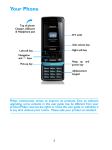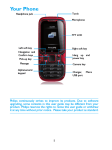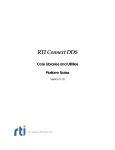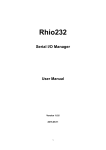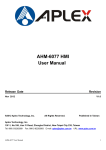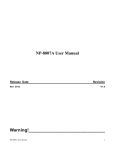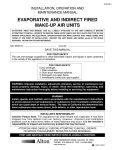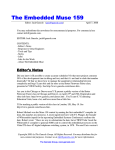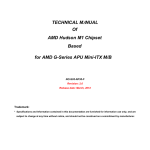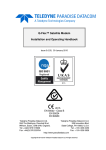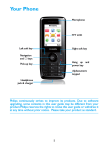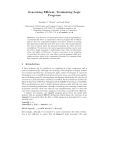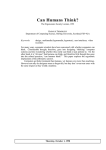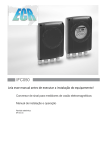Download How to wield PC Lint - JB Enterprises – Johan Bezem
Transcript
JB Enterprises
Johan Bezem
How To Wield PC Lint
2009.01.16
How to wield PC Lint
Abstract
Using PC Lint has become standard in many development efforts using C or C++. Several
project leads I know insist on its usage, since they know the potential benefits. However,
having been intimate to many C/C++ projects in the last several years, the sophistication of
Lint usage differs greatly. In many projects, he PC Lint user's manual is rarely taken to hand,
the plethora of options available are mostly unknown, and several error messages are not
well understood.
The short chapter "Living with Lint" in the user's manual doesn't really solve the problem if the
user isn't sufficiently literate with lint options.
So, over the years I have collected some "best practices", to be presented here. On many
occasions I have been pushed into projects without any previous Lint contact. Digging
through the massive amounts of messages isn't easy, but do-able if you take a structured
approach.
Finally, I also give some hints as to how to use the various Lint options to their fullest.
Yes, everything written here can also be found in the manual. But the information is scattered.
Here I present you my roadmap, single-stepping through the various acts of cleaning your
code.
One more remark: To limit the scope and size of this document somewhat, I'll concentrate on
pure C and leave out a discussion for C++. Parts of the document are generally applicable,
and strategies will be the same, but especially a discussion of specific error-types leaves out
all C++ discussions.
Structuring Lint options
One of the first pitfalls lies in the way to utilise the various Lint options. Especially when you
encounter a project where PC Lint has been used all along, you will see code littered with so
called "Lint Comments", special C/C++ comments intended for PC Lint, containing Lint
options.
Now, PC Lint has several places where it reads its currently valid options:
From the command line
From special Lint option files (usually called *.lnt)
From within the source code modules, in Lint comments
OK, you may also create a special include file, containing definitions relevant only to Lint, and
use a special option -header(…) to indicate this to the program. Until today, I have never felt
the need, but your style may be different.
So, most installed projects using PC Lint I have seen use some options on the command line,
and then litter their code with lint comments. This will work as long as you keep the Lint
comments in sync with your code. And be honest: You always do that, don't you?
Using option files
Here's my way. I use three separate option files for PC Lint, called loptions.lnt,
project.lnt, and temp.lnt. So my command line looks as follows:
lint-nt -b loptions.lnt project.lnt temp.lnt <sourcefiles>
The -b option only works when given on the command line, therefore I need it there, then the
three option files, after which come the source files. I try to avoid unit-checkout ('linting' single
files in isolation) because of the reduced error output, but if you wish, use -u for that.
And if you're into Lint-Object-Modules, you'll probably not need this introduction in the first
place.
loptions.lnt
The file loptions.lnt has been more or less the same for me since I adopted this structure.
It contains just a few options, and those only of a general nature:
Message presentation: How shall Lint messages be formatted
Error output: What value shall Lint return to the operating system after processing
htwpl.doc
Page 1 of 12
JB Enterprises
Johan Bezem
How To Wield PC Lint
2009.01.16
How to handle libraries: Shall we lint them together with the code, or better ignore
them
How many passes do we need
Directory structure: Where are the rest of the configuration files to be found
(project.lnt, temp.lnt)
That's it. For being so general, I can reuse the file for any new project.
project.lnt
Here's where the action is. Whatever your project needs as far as project-global Lint options
are concerned goes into this file: Tab-size, library headers, project conventions (is char
signed or unsigned? Are trigraphs allowed? Do we allow early modifiers? May we use
enumerations and integers interchangeably?)
This is the file we'll be discussing most, but not here.
temp.lnt
This file is empty. Or at least it should be. In any version control system it shall be checked-in
containing just comments; but in my workspace, it may contain many error inhibition options.
This file I use to reduce the massive number of error messages to a number I can handle.
And as soon as I have solved most issues, I reduce the contents of this file, and work on the
next chunk.
Is it possible to use less option files? Yes, it is. If you want, you may put all three parts into
one file. Having this file split in 'responsibilities' makes sense, but putting it all in one file
doesn't detriment your possibilities.
But having them in three files enhances reusability.
Is it useful to have more than three option files? This depends on your project structure. If you
work in a department developing for six different processor platforms (e.g. x86, IA64, ARM,
etc), using four different compilers (Microsoft 6,x, Microsoft .NET, GNU GCC 3.x/4.x, etc.), it
may make sense for you to have one global loptions.lnt, one compiler-specific comp.lnt,
one platform-specific platform.lnt and one project-specific project.lnt, as well as
temp.lnt. Look at your environment, and make an informed decision, based on reusability.
Where to put compiler specifics
I guess this is a matter of taste. In my environment, the compiler-specific options (like the size
of 'int', 'long long', 'short', alignment, specific macros the compiler defines for you, etc.) are
put in a special file and included in project.lnt. You may also add a fourth file to the
command line (before project.lnt), or create a wrapper file, say wrap.lnt, including all
three or four, reducing the length of your command line. As long as the ordering is kept intact
(offering the possibility of overriding more global settings at every subsequent level), and
each file discussed is physically separate for reuse-reasons, the form of execution is of no
importance.
Be aware that Gimpel offers a whole slew of compiler specific option files, called
co-<comp-abbr>.lnt, installed with the product or offered on their website. Be sure to check
there regularly, since these files get updated occasionally. They present a fair starting point.
However, being into embedded development, I have regularly had a compiler not supported
"out-of-the-box", so I wrote such a support file by myself. You may take the offered option files
as samples, of course.
Accommodating individual requirements
Especially the error formatting requirements differ from developer to developer. At least in
teams where the environment is not a matter of dictatorship, every code editor is a little
different. And since developers are lazy by nature (at least I am), they will want to handle Lint
messages like compiler errors/warnings, and be able to jump wherever is pointed by pressing
a key.
So, in some projects you'll have the need to override some settings on an individual basis,
without compromising your Makefile-integrity. You'll have to find your own way, but if I have
control over the Makefiles, I usually add an option like "if you find a file called individual.lnt
at such-and-such position in the file system, add that filename between temp.lnt and the
htwpl.doc
Page 2 of 12
JB Enterprises
Johan Bezem
How To Wield PC Lint
2009.01.16
source files in the command line for PC Lint of the Makefile". Since the Lint option files do not
have any possibility for conditionally including options, this seems a viable way to go.
Source filenames on the command line
Those of you working with UNIX (or Cygwin, or…) are lucky for having a very long command
line (usually 4096 characters or larger). Those of us working with Windows (or even MS-DOS,
yes, they're still among us!) usually have to stay below 256 or even 128 characters per
command. So, unless you're into very small projects, the command line will be too small
(sometimes even on UNIX!) for listing all relevant source files on one command line.
I usually direct my Makefile to create or update a file called files.lnt with all the C/C++
source file names making up the final executable. This would be the fourth (or fifth) filename
to be included on the Lint command line.
Where to send the output
One more issue has to be addressed before we can present the full command line. Lint is a
tool, apparently made by programmers for programmers. It doesn't offer a flashy GUI, where
you can point-and-click through your messages. It used to be a DOS program (I do not know,
whether a UNIX variant has been available in those days), and as far as I know it will still run
on MS-DOS in the current version. So it was and is restricted to two output channels, stdout
and stderr (by default, your screen is targeted). The screen is not a very efficient recipient of
information, especially when the amount is as large as Lint will happily make it. Lint-runs to
the screen easily take 20 times as long compared to redirecting the output to a file, when
running a command line under Windows (CMD.EXE).
Most command shells, including the Windows DOS-box, offer redirection possibilities. If you
like, use those. However, command shells are all different, both in behaviour and in syntax.
Therefore, I use the option offered by Lint: -os(lintout.out).
Where to put this option? loptions.lnt would present itself, since the (single) output
filename will probably remain the same over projects. But if the project (-manager) dictates
such a name, projects.lnt would be perfect. temp.lnt shall remain empty.
I put this option on the command line, for one reason: When integrating Lint in your Makefile,
you'll probably use a make-target called "lint" or "lint_all". If, as far as the make program is
concerned, the error file can be viewed as another make-target, make can decide for itself,
based on file timestamps, whether a new Lint run is necessary. In that case, the filename will
be integrated in the Makefile, so it would be natural to be able to include it on the Lint
command line. Even name changes between projects can easily be accommodated this way.
So, the command line to be used would look like this:
lint-nt -b -os(lintout.out) loptions.lnt project.lnt temp.lnt
individual.lnt … files.lnt
(The dieresis '…' indicates that this command line is just one, broken in two for layout
reasons).
One word of warning: The -os option needs to be given before the first output-generating
option is presented on the command line (directly or indirectly), but, especially in a Makefile,
you would not want one of the options files to override the value presented on the command
line. Therefore, the position of the -os option has been chosen for a reason.
See also the use of +flm in loptions.lnt.
My global options
The file loptions.lnt hasn't got much to do with the task at hand, but just to get a starting
point I'll present the options I usually use, with a few remarks.
htwpl.doc
Page 3 of 12
JB Enterprises
Johan Bezem
-wlib(1)
How To Wield PC Lint
2009.01.16
// Only report errors from the libraries
// Output: One line, file info always, use full path names
-hF1
+ffn
-"format=%(\q%f\q %l %C%) %t %n: %m"
// Do not break lines
-width(0,0)
// And make sure no foreign includes change the format
// or the output option
+flm
// Warn when trigraphs are used
-ftg
// Include files within library includes without full path
+fdi
// Don't stop make because of warnings
-zero(99)
// Make sure to make two passes (for better error messages)
-passes(2)
// Include directory where other option files *.lnt are located
-iC:/Lint90/lnt
// Don't let -e<nnnn> options bleed to other source files
-restore_at_end
// Produce a summary of all produced messages
-summary()
Let's discuss these one by one. Details on the various options can be found in the Lint user's
manual, so I will not cover everything here.
-wlib(1) reduces the flood of errors and warnings from libraries I have no control
over. Since Lint is very powerful in respect to determining what is and what is not a
library, this is just a global precaution.
Start with '1' (one) for a good reason: Lint will report any errors it finds, no warnings,
info’s or notes. But the errors, if any, will alert you to some very valuable findings,
such as missing types, incomplete definitions or declarations and the like. This will
alert you to some configuration problems you might experience, like (compiler-)
predefined macros that Lint knows nothing about, or wrong ordering of include files,
making Lint find the wrong include file first.
As soon as your project is in good shape, use temp.lnt to experiment with different
settings (2, or even 3). If you're confident about the new settings, incorporate them in
project.lnt (don't use loptions.lnt, since you wouldn't want a new project to start
out at warning level 3 for the libraries!).
-hF1, +ffn formats the Lint messages a certain way. I don't need any source code
context in my warning messages if I can jump to the exact location in my editor by
simply pressing a key; I don't need an indicator as to in which column Lint recognises
a potential problem, if my editor can not only jump to the indicated line, but also to the
indicated column (note the difference between %C and %c, counting columns starting
at zero or one, depending on your editor's requirements!); I need the full pathname
indicated in the message, so my editor can find the file no matter what its current
directory happens to be.
-"format=%(\q%f\q %l %C%) %t %n: %m" this is just the format I happen to like. Note
the quotes; they are needed because the option string contains spaces. And note the
‘\q’ around the filename ‘%f’, they make Lint emit quotes around the filenames in all
messages it produces, to allow source paths also containing spaces.
-width(0,0) For better processing I like one line per message, no matter how long
that line gets (in C++ lines can get very long indeed!).
htwpl.doc
Page 4 of 12
JB Enterprises
Johan Bezem
How To Wield PC Lint
2009.01.16
+flm locks-in the so given message format. It is up to you whether or not to use such
an option, but I have seen different message format options located in Gimpelprovided compiler option files (like co-msc90.lnt). In addition, this option locks-in the
–os option for indicating output redirection, so you'd better place that option (on the
command line, if you will) before this one.
-ftg disables tri-graphs, or better: It makes Lint warn you when tri-graphs are used in
your code. I see no need to use tri-graphs in my code, and I would like Lint to warn
me when a character sequence is used which is interpreted differently from what I
have written. YMMV.
+fdi depending on how projects are split into directories, and how the compiler
includes like stdio.h are structured, include files refer to sibling includes without
specifying a path. So, by default, I'd like to adopt that convention. If need be, I can
override the setting in the compiler- or project-specific options. On UNIX (FlexeLint),
this is the default.
-zero(99) when starting with a new Lint project I definitely want this option gone
(using -zero in project.lnt), otherwise my Makefile will always terminate
prematurely. However, for stable projects, regularly linted, it makes sense to abort
make when "real" errors are found using Lint (probably your compiler would also
complain).
-passes(2) again, when starting with a new Lint project I'd want this option reduced
to one pass only. Two or more passes only makes sense when the project is at least
moderately cleaned. In general, however, two or more passes makes sense, since
Lint can perform better quasi-dynamic checks using value-propagation techniques.
-iC:/Lint90/lnt because I use my own copy of PC Lint on my laptop, where Lint is
always installed in the same directory ;-), I indicate this directory here. Your
environment might benefit more from such an option in project.lnt, and it will
probably use a different pathname. Note the use of forward slashes in the directory
name. Especially when using relative pathnames, option files can be shared between
Flexe-Lint ("PC Lint for Unix") and PC Lint, between UNIX and Windows.
-restore_at_end provides a kind of sandbox concept for each source file when you
present multiple files to Lint in one run. Without this option, Lint comments like
/*lint -e8?? -w1 */ will be valid not only for the file containing this comment, but
also for all subsequent files. It was added at my request in version 8.00v, and now
officially part of version 9.0.
-summary() provides a handy way to look for certain types of warnings. Lint will
produce one line indicating the type of warning for each type generated. Especially
with really large output, looking at the summary may be faster than searching the
whole file.
An existing project without previous Lint exposure
We have a basic loptions.lnt, an empty project.lnt (possibly only including the correct
compiler-options file), and an empty temp.lnt. Now let's get down to work.
Project defines
Most projects specify at least one or two macros on the compiler command line, if only
something like -DTARGET=RELEASE. Such options (usually contained in Makefiles or command
scripts) have to be provided for Lint also.
If you're using a Makefile to start Lint, provide the same options in the same way as for the
compiler. But if you want you may also specify them in the project.lnt file using the same
syntax. If there are more macros defined like this, provide them all, or use common sense to
differentiate which ones are really necessary.
One issue you might encounter: Most compilers offer an initial set of predefined macros.
Unless you are lucky to find a Gimpel-provided co-<name>.lnt file containing the settings for
exactly your compiler, you will have to provide these to Lint. Since Lint caters for all known
compilers and then some, Lint cannot build-in a set of predefined macros. But if the includefiles provided with your compiler (and believe me, Lint had better use exactly those!) assume
the definition of those built-ins, you will have to educate Lint. Exactly how, is up to you:
Browse the manual, ask some colleagues, or, new for Lint 9.0, use the –scavenge option. The
htwpl.doc
Page 5 of 12
JB Enterprises
Johan Bezem
How To Wield PC Lint
2009.01.16
-scavenge option has been added to Lint to aid in the process of finding out the implicit
compiler defines. The process to do so is a multi-step process that may need repetitions
whenever the compiler options are changed. The details are described in the manual, so I will
simply point you there.
And if you are lucky, your front-end is called ‘EDG’ version 3.9 or later (compilers like Intel,
IAR, Green Hills, TI, Comeau and others) you may look for an option --list_macros which
enables you to list all predefined macros. If you use the GNU compiler tool chain, the option
-dM may do the same. Check the respective manual.
One hint: Until you have cleaned out most of the messages, stick to only one build-type for
Lint (DEBUG or RELEASE), best is to use the same configuration as is regularly used for
development, usually DEBUG. Later in the project you may choose to perform Lint for some
more or all of the configurations.
Include directories
1
If we now run Lint, it will probably abort because of include-files it cannot find. So, let it run,
examine the last few lines of output, and locate the include-file in your source directory or in
your compiler's library includes. Then add the option -i<directory> to your options. Don’t
even look at the many warning messages; they will only later become relevant.
If you use a specific file for compiler options, be sure to add the corresponding include options
to that file, if the path belongs to the compiler includes; otherwise, add it to the project.lnt
file.
For details as to how Lint searches for and finds include-files – including the use of the
environment variable INCLUDE – refer to the Lint User's Manual. But one issue is still relevant
here. Sometimes you will get error messages from Lint concerning include files it cannot find,
but then you cannot see why. Consider this scenario:
If your C file includes an file in another directory, like #include "abc/def.h", and the
directory abc is not in the regular 'include-path', you may run into trouble if, say, def.h
includes gkl.h, located in the same directory abc, without indicating the full path,
#include "gkl.h" instead of #include "abc/gkl.h". If you've taken my loptions.lnt file
2
without adaptations, all's fine. If not, please check if you have included the option +fdi at
least in project.lnt, since that option teaches Lint to look in the including file's directory for
further includes.
Repeat this procedure until Lint completes its full run. In that case, the last few lines of output
do not indicate a missing include file. Verify that all include paths are found by searching
backwards for the string "Global Wrap-up". If it is found, Lint has produced a full output, and
we're set to start analysing.
Library includes
OK, if you really have library include files (from your compiler, or from bought libraries like
operating system, network management or math packages), be sure to list them as such. Use
the option +libdir(<directory name>) if all the include files in that directory are to be
considered library headers, or use +libh(<filename>) for individual files. Especially when
starting out with Lint, run the program immediately afterwards and check that the appropriate
messages have effectively disappeared; you wouldn't be the first to use wrong path- or
filenames and not notice until far too late.
Most such options belong in the file project.lnt; some might belong in your compiler options
file, if you're using such a file.
Layout and indentation
My personal opinion is never to use tabs for indenting blocks of code. Modern development
editors can be configured that way, at least for source files. But usually 'some colleagues'
can't get their settings right, so tabs seem to be a fact of living.
If, in going through your messages, you encounter many messages concerning an
unexpected indentation (search for the keyword "indentation"), there may exist a mismatch
1
If you find Lint stopping because of a #error directive, find the reason (usually a missing or
imprecise macro definition) and remedy that.
2
This option is active by default for Unix/FlexeLint installations.
htwpl.doc
Page 6 of 12
JB Enterprises
Johan Bezem
How To Wield PC Lint
2009.01.16
between your ideas of a tab's size calculated in spaces, and Lint's. In such a case, check your
coding guidelines, and provide the option –t2 in your project.lnt options file (replace the '2'
with the number of spaces equivalent to a tab in your project). Rerun Lint, and check the
results (not the details, just the total number of messages as compared to the previous
situation); this will give you a very rough idea as to the amount of tabs still in use, and it will
flag the layout inconsistencies based on correct assumptions.
One other layout related issue you might encounter concerns the typedef names of
structures/unions/enums: If they are not on the same line as the closing brace, consider
changing the layout (recommended) or switch off message 659 by using option -e659 in your
project options file.
Signed or unsigned characters
Never mind the messages, neither by number nor by content. Usually, characters are seen as
unsigned. Now, since the standard doesn't require one or the other, most compilers as well as
Lint can handle all three cases: "Characters are signed", "characters are unsigned", and
"characters are neither signed nor unsigned". In the last case, char, unsigned char, and
signed char are all three considered different types. Be sure to let Lint know which of the
three you intend for your project, for instance by specifying +fcu in your project options file.
Especially when specifying -fcu, be sure to specify so after including your compiler's options,
since many compiler's option files as provided by Gimpel specify +fcu, possibly overruling
your project's setting. On using C++, consider the +fdc-option to distinguish all three forms
(overloading!).
If you never use the 'plain' type char, and you only explicitly use either unsigned char or
signed char, this will not make any difference to you. Enable warning +e971 if you want to
find all cases where char has been used without signed or unsigned.
Using enumerations
Strictly taken, enumerations are separate types with a limited number of valid values. The C
standard, however, doesn't enforce this separation, and many C compilers consider enums to
be equivalent to integers. If you want PC Lint to adopt this 'loose integer model', specify the
option +fie in your project option file. In that case, enums can be assigned to integers and
vice-versa; you may loop through a set of enum values, etc. But you may also assign
basically invalid values to enum-type variables without Lint complaining about it, so consider
your options carefully.
Using bit fields
If you're into embedded development like me, your code probably has bit fields all over. A
portable use of bit fields uses unsigned to declare the bit fields, like
struct B { unsigned a:4; };
The standard will also allow signed or int for declarations, considering the bit field to be
signed. However, some compilers and/or developers will still treat the bit fields as unsigned.
Specify the option +fbu if your environment is like that.
Some environments are even more relaxed, allowing type declarations like char, long or even
enumerations to declare bit fields:
typedef enum { false, true } eBool;
typedef struct BF
{
char ec:2;
long el:2;
eBool eb:1;
} BF_t;
For PC Lint to accept this as a valid bit field declaration, you'll have to switch off message 46
(to be able to use other types than signed or unsigned integers) using option -e46, and if
using enumerations to declare bit fields is common in your source code, also specify option
+feb in your project option file.
htwpl.doc
Page 7 of 12
JB Enterprises
Johan Bezem
How To Wield PC Lint
2009.01.16
Pre-processor expressions
Some C compilers allow the use of enums and constant variables in pre-processor
expressions, like:
const int cVar = 5;
#if cVar < 6
...
#endif
If you want PC Lint to allow such (non-standard) use of the pre-processor, include the option
+fep in your compiler options file or in project.lnt, whichever you prefer.
Inline assembler
The world of embedded systems uses inline assembler frequently, and PC Lint is able to
handle most variants I have seen to date. Let's consider three common variants.
If inline assembler instructions are framed with pragmas like in
#pragma asm
mov r1,r2
#pragma endasm
For these assembler instructions to be ignored by Lint you need to switch off checking using
the option +pragma(asm,off), and re-enable checking using the option +pragma(endasm,on).
For most PC-based compilers it might be sufficient to enable the Lint-specific special keyword
asm by providing the option +rw(asm). However, if an inline assembler routine is fitted with a
C-like prototype, this will not be sufficient. Consider:
asm int iGetCurrentSp(void) { mov sp,r10 }
Here we need Lint to ignore the function body. For that we enable not only the Lint-keyword
asm, but also the 'gobbler' keyword _ignore_init. Specify the option +rw(asm,_ignore_init),
or just _ignore_init if you already enabled asm before. Define a Lint-specific macro
replacement using the option -dasm=_ignore_init. Lint will ignore the 'initialisation', which in
case of a function definition means the function body.
And, finally, consider the variant __asm("mov sp,r10"); embedded within normal C code.
Since it clearly cannot be considered an initialisation, not even in the broader sense like
before, we'll again need a new construct. For this to work, specify another 'gobbler' keyword
_to_brackets using the option +rw(_to_brackets), and let Lint know to ignore the brackets
(everything in between included) after __asm using the macro replacement
-d__asm=_to_brackets.
I've seen all three variants supported in one compiler, and, thanks to various external
libraries, also used simultaneously.
If your environment supports and uses different variants, you can experiment with the
techniques described here. Also consider the existence of even more 'gobbler' keywords (to
be enabled with the +rw(...) option first) like _gobble, _to_semi, and _to_eol.
A first run
If you're in a situation similar to mine, you need to produce first results quickly. So, run Lint on
the sources, and be sure to redirect the output to a file. I've seen initial Lint-runs take more
than an hour on a moderately complex project (less than 400 source files) when the output
scrolls through a DOS-window on a fast Windows XP machine. With redirected output, the
process took only a few minutes, producing more than 100,000 lines of output.
How to handle a file with thousands of lines of messages? It is totally impractical to go
through it line-by-line, that would take a year. So use a decent editor capable of handling
large files efficiently, and use the search feature.
From my experience, there are a few searches that will get you up to speed and find the most
prominent mistakes quickly. Of course, these string searches could also be replaced by
searches for specific error numbers. However, PC Lint evolves and produces new error
messages in most every new version. Using the words instead of the unique numbers
enlarges the chance to also catch new errors.
Please be aware: The following search ideas are intended as a guideline. Feel free to vary
your searches as you think fit. Also, some searches may overlap, so sometimes they might
direct you to the same messages.
htwpl.doc
Page 8 of 12
JB Enterprises
Johan Bezem
How To Wield PC Lint
2009.01.16
Important: Never disable errors with a number below 400, unless the manual says you can.
Such errors usually have a real cause (configuration problems?) and need to be resolved, not
suppressed. If you suppress them, changes are that subsequent errors appear because of
these errors, but you’ll not be able to find the root cause.
Memory corruption and other quickly found errors
The most obvious serious errors Lint can find are broadly related to memory corruption. The
keywords we look for are "division by 0", "out-of-bounds", "beyond array", "data overrun", "null
pointer", "suspicious use of", "memory leak", and "custodial pointer". Be sure to switch off
case-sensitive and whole-words-only searching.
This way we're looking for presumed access outside of array boundaries, null pointer access,
malloc/free errors and memory leaks and a few curious constructs. All messages thus found
indicate pieces of code worth looking at in some detail. Again, do not dismiss a PC Lint
observation too lightly!
The messages thus found may indicate a real error, or they may indicate a misinterpretation
by PC Lint. At this stage it is not useful to do more than just glance over the area indicated. If
the source code has never been submitted to Lint analysis, chances are quite good to
immediately find some real problems in your source code. Report or correct these
immediately, and continue looking. Do not add Lint comments or specific options for all those
locations where you cannot find a real error, and simply want to silence Lint. We're not that far
along.
The next steps
From here onwards, we have two possibilities: Start cleaning the header files, or concentrate
on the implementation files. Since I'll discuss the cleaning of the header files extensively, let
me briefly explain the other option.
Ignoring messages from all include files is quite easy. Using the option +libh(*.h) effectively
all include files are declared library header files, and because of the –wlib(1) option they are
largely ignored. Their contents are not ignored, however, and that presents one of the
potential problems with this way of working. It is quite possible to find messages for
problematic points in the C files originating from an ignored problem in some include file. That
is the reason I personally start working on the header files first.
Classifying messages
Take a look in your output file. For every message you'll have to decide – at some point in
time – whether you want to change the code to conform to Lint's expectations, or if you want
to tell Lint to ignore this issue. If you want to change the code, go ahead and do it. Since I do
not know a thing about your code, you're on your own there.
I'll here concentrate on telling Lint that everything is OK, while retaining as much error
detection capability as possible.
Silencing Lint is easy. I've seen a developer starting all his C-files with the option –e*,
effectively disabling Lint for all his modules and include files. Until I found his Lint-comments,
he was highly thought of. The difficulty lies in retaining Lint's capabilities to the fullest
possible.
To illustrate the advantages and disadvantages of some method, I'll discuss a few common
situations in detail.
Macros TRUE and FALSE
Many environments using C89 have defined macros called TRUE and FALSE. FALSE is defined
as 0 (zero), and presents no problem. If TRUE is defined as "!FALSE", Lint will complain
because of a 'constant value boolean' (message number 506), which is basically correct but
still intended here. And since these macros tend to be used quite often (including other
variants and macros), a plethora of messages is produced.
Several options exist:
Disable message 506 globally by adding the option –e506 in your project options file.
This alternative has the grave disadvantage that relevant messages from other
contexts are suppressed as well.
htwpl.doc
Page 9 of 12
JB Enterprises
Johan Bezem
How To Wield PC Lint
2009.01.16
Use a Lint-comment within the include file where the macros are defined, disabling
message 506 after the definition, like /*lint –e506 macro TRUE, intentional */.
OK, this is a little better, but not much. Potentially many files will include this header
file, and the slight advantage over the previous option is almost gone.
Use single-line suppression like /*lint !e506 macro TRUE */ everywhere the macro
is used. Now this works almost perfectly (except for similar errors in the same line),
but it is extremely tedious to do, and you won't remember it at all times.
Use the single-line suppression comment within the definition of the macro, like in:
#define TRUE !FALSE /*lint !e506 */
This would seem to work, since Lint doesn't quite discard all comments, only the nonLint comments. However, this sort of comment is not allowed (cf. User's manual,
section 5.1, "Options within Macros").
The way to get the previous (invalid) alternative working is to use the option –save in
a Lint comment:
#define TRUE /*lint –save –e506 */ !FALSE /*lint –restore */
This quickly becomes unreadable, but it will work.
Equivalent, but easier to read in source code, would be to use the option
-emacro(506,TRUE). This option has to precede the macro definition, so place it in a
Lint comment before defining the macro, or preferably in your project options file.
Clearly the last alternative has my personal preference: Used either just before the definition,
or even in your project options file, the effect is to only suppress the irrelevant message in
those cases where it really is unnecessary. And it keeps your code readable.
3
Another issue with macros like TRUE/FALSE or VALID/INVALID arises when MISRA -rules are a
requirement. The specific rule (rule 49 in the 1998 standard, rule 13.2 in the 2004 standard)
reads "Tests of a value against zero should be made explicit, unless the operand is effectively
Boolean." For details, refer to the MISRA specification.
This requirement has implications for our macros, since we are not allowed anymore to
specify like this:
int fIsValueValid(int iValue);
...
if (fIsValueValid(25))
{
...
}
We are required to specify "if (TRUE == fIsValueValid(25))" instead, and if TRUE is defined
as "!FALSE", message 731 "Boolean argument to equal/not equal" is produced.
In this case, specifying the option –emacro(731,TRUE) is not sufficient (refer to the location
where the virtual –restore option would be placed), since the complete expression is the
source for this message.
If you still need to work like this, consider using the form –-emacro((731),TRUE). This will
place the message inhibition in the syntax tree and cover the entire expression in which the
macro is used. For some messages (not message number 731 as in this example) you may
even need to consider using the form, –-emacro({731},TRUE). For details, see the Lint
documentation.
Important is: Start with the simplest inhibition options, and only use the more powerful ones
when really necessary. Otherwise, your messages will disappear, but other (unaddressed)
messages may also be suppressed. Let 'good enough' be sufficient!
Using assert and derivate functions
Using the function assert to validate assumptions at least in debug code makes absolute
sense. If the condition presented to the assert macro is false, assert will call the function
abort. The macro, however, is part of the Standard C Library and defined in assert.h as
offered by the compiler tool chain. And even if you never include the library include assert.h,
3
MISRA: Motor-Industry standard for programming in C; increasingly relevant for embedded
development in the automotive industry.
htwpl.doc
Page 10 of 12
JB Enterprises
Johan Bezem
How To Wield PC Lint
2009.01.16
MISRA (and common sense) prohibit the redefinition of anything defined in the Standard C
4
Library .
Embedded systems therefore frequently create their own assert facility, usually without any
reference to the Standard Library.
Now back to PC Lint. PC Lint knows the semantics of the assert macro: That the argument is
checked for true/false, and if the condition is false, the assert macro (sometimes a function)
will not return to the caller. It will also use the knowledge about the truth of the condition to
enhance its knowledge about the values of variables. Similar knowledge is available on the
exit and abort functions.
Let's have an example:
#define MyAssert(cond) { if (!(cond)) MyAbort(); }
extern void MyAbort(void);
int LocalArray[10] = {0};
int main (void)
{
unsigned int uLoop;
for (uLoop = 0; uLoop < 10; uLoop += 2)
{
MyAssert(uLoop < 9);
LocalArray[uLoop] += LocalArray[uLoop + 1];
}
return 0;
}
Since the loop counter is incremented in steps of 2, the largest value for uLoop will be 8, so
LocalArray[uLoop + 1] will be a valid array access. PC Lint will complain, though, since the
current version (tested with version 8.00t) does not realize that incrementing will stop after 8.
The MyAssert statement would be the way to tell PC Lint, but PC Lint doesn't know about the
special properties of MyAbort. Try the PC Lint command:
lint-nt –u LintTest.c
This will produce message 661:
Possible access of out-of-bounds pointer (1 beyond end of data) by operator '['
But if we tell PC Lint that MyAbort is like exit in that it will not return to the caller, PC Lint will
discover that the for-loop body cannot be executed with uLoop equal to 9, accessing the out-
of-bounds pointer, and the message will disappear.
lint-nt –function(exit,MyAbort) –u LintTest.c
Yes, this solution has been described in the manual, refer to chapter 10.2.1. However, there
are more possibilities than described in the chapter; the implications of defining everything
yourself are not clear to some developers; and finally, this article is much shorter than the PC
Lint manual.
A final few words
Would you use a blunt knife, unless you need a screwdriver? Not likely. So, sharpen your
knife! Patch Lint to the most recent patch level (9.0b at the time of this writing, January 2009,
or if you are still using version 8, the patch level is 8.00x; consider upgrading to 9.0, it's more
than worth it!). Patching is free for everyone within a major version: a license for version 8.00
gives you every patch up to 8.00x, independently from your current patch level. And the same
is true for version 9.0.
And if you really use version 7.50 (some are among us still), at least use version 7.50ad, that
patches page is yet available, and seriously consider buying an upgrade to version 9.0b or
later.
If you need support with your endeavours, don’t email me directly, but go to
http://www.gimpel.com/Discussion.cfm, a forum for peer-support. Yes, I hang around there
quite frequently, but I’m not the only one, and I might have an assignment keeping me away
from the Internet for a while. I will also refer any direct questions to that forum.
4
MISRA-C: 2004 Rule 20.1: Reserved identifiers, macros and functions in the standard
library, shall not be defined, redefined or undefined. assert is specifically mentioned.
htwpl.doc
Page 11 of 12
JB Enterprises
Johan Bezem
How To Wield PC Lint
2009.01.16
And yes, I also offer consultancy, so if you need someone to do this for you, please _do_
email me, I’ll be glad to make you an offer, on-site or off-site, perfectly tailored to your needs.
But then, this document is not an advertisement, so I’ll leave it at that.
Postscript
I have the hope that this document will prove useful to many developers with access to PC
Lint as a tool, but no real experience in wielding it. And maybe even some experienced user
can find something new, as I constantly do.
This article has been intended to augment the chapter "Living with Lint" in the PC Lint
manual, but it cannot replace the full manual. If you will, try the methods I have outlined, read
relevant parts of the manual, and organize your options in a way useful to you. And before
using Lint comments in your source code to eliminate individual messages or groups of
messages, ask yourself if there could be a way using just the configuration files, not touching
the code proper.
If new issues arise, or questions to certain problematic areas accumulate, I may produce
newer versions of this article. Comments and criticism are always welcome.
Good luck linting!
htwpl.doc
Page 12 of 12












